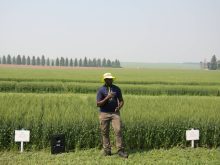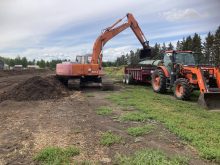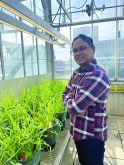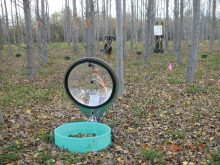Glacier FarmMedia – Boosting nitrogen use to reduce nitrogen-based fertilizer applications, has been a feature of several products in the past five years.
Lalrise Start SC liquid inoculant aims to improve another key nutrient. The seed treatment designed to enhance phosphorus solubility has received full commercial registration and will be available in spring 2024 for spring wheat, oats, barley and rye.
Canola, corn, soybeans, pulses and winter wheat are also on the label and the product will be available for those crops in the future.
Read Also

Moo translator and methane measures: There’s an app for that
Dalhousie University researchers use artificial intelligence to create new dairy farm apps that analyze cattle sounds and measure methane.
Traditional inoculants geared to pulses and legumes use Bradyrhizobium japonicum or Bacillus subtilis. Lalrise Start SC employs a new strain in its product formulation – Bacillus velezensis.
That strain is a plant growth-promoting rhizobacteria selected to increase crop establishment via improved root vigour and nutrient availability.
“What you have is a highly concentrated suspension that will give the seed a package of growth promotion because of a biofilm of these bacteria,” said Matt Pfarr, field solutions manager with Lallemand Plant Care, the company behind the seed treatment.
“This product is very different because it’s going to focus on phosphorus fertility. We’re complementing the grower’s fertility placement because up to 90 per cent of that can get tied up within one year of that dollar being spent, so we want to give the grower back that 90 cents in availability.”
In research and registration trials in 2022, Lallemand showed a 38 per cent increase in phosphorus availability in situations where phosphate is tied up in an organic or inorganic (mineral) form.
The plant uptake can be 25 per cent greater in the early stages of growth, helping with establishment and early vigour and leading to potential for healthy grain set. In theory, it should increase the number of grains on the head.
“With the Lalrise Start SC bacteria, they’re more like a probiotic, where we’re more interested in how they can colonize outside of the root, and plants are always giving carbon into that space,” said Pfarr.
“We’re hoping beneficial bacteria will come with beneficial fungi and colonize that root zone. We know Bacillus velezensis is aggressive and forms this biofilm and can colonize very well.”
More detail on soil
Pfarr acknowledges the industry is still in its early stages where soil health and root zone interactions are concerned, and growers have questions about any new inoculant. What is the effect? What does it do for crops? What is the mode of action?
He likens the potential to investing in the root’s architecture at an early stage. There’s growth stimulation and the structure produces phyto-hormones that the plant will respond to and develop a more robust root system.
“We’re exploring that soil and then we enter an exponential growth phase of the vegetation of the shoot a little earlier than the non-treated,” said Pfarr. “There’s a bit of an investment period, but then five to six weeks after emergence, we see improvement over the untreated, and that leads to higher yields.”
Lalrise Start SC is billed as a resource for growers that uses the right solution at the right time in the right form and at the right rate. The question from Pfarr’s perspective is the metric on what the inoculant will bring.
“Whether it’s for stress mitigation or promoting the diversity of the soil microbiome, there’s a lot to be done,” he says. “We’re just appreciating that more and we’re going to manage for that. But we have to be able to measure it and get more looks at it.”
– This article was originally published at Farmtario.















